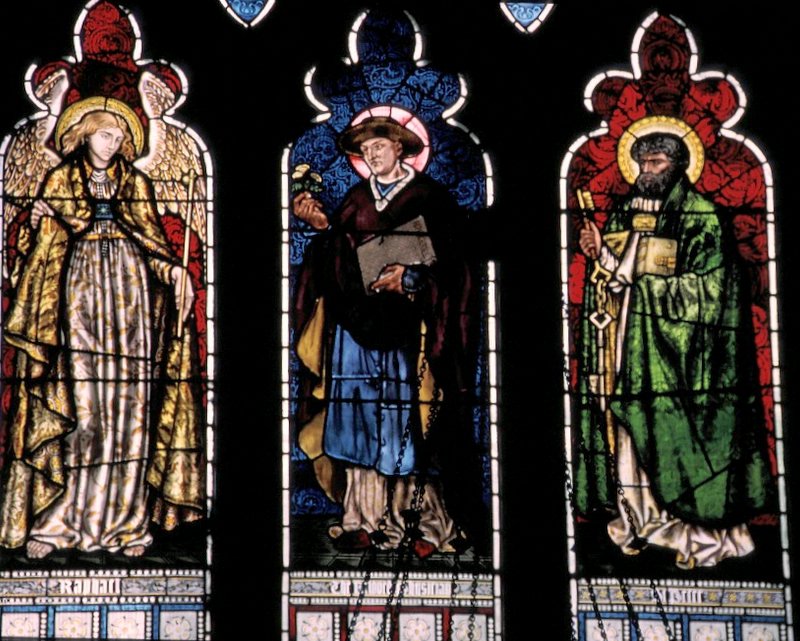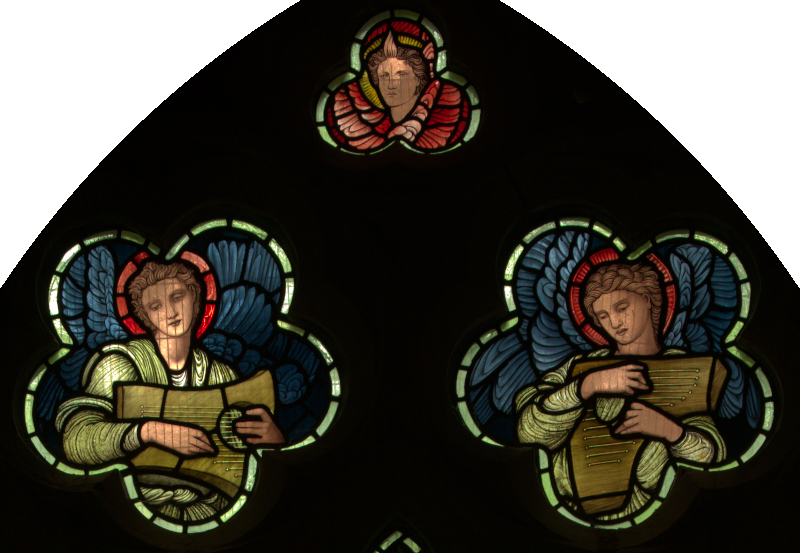The Morris windows at St Ladoca, Ladock, Cornwall
This article was originally prepared at the request of St Ladoca’s Parish Council.
The windows in the Chancel east, Lady Chapel east and south aisle west at St Ladoca parish church, Ladock were all made by the William Morris studio of London. This studio was formed by Morris in , originally as Morris, Marshall, Faulkner & Co., and was re-organised in as Morris & Co. (‘the Firm’) and re-located to Merton Abbey, London. At that date Sir Edward Burne-Jones replaced earlier artists of the calibre of Morris, Rossetti, Madox Brown and Webb as the sole stained glass designer, a position that he retained until his death in , two years after the death of Morris.
The two east windows were inserted during the earliest phase of the Firm in the 1860s, whereas the west window is a product of the final decade of the Firm at the end of the nineteenth century. Another early Morris window is nearby at St Michael Penkevil (Chancel east, ). The only Cornish window that represents the middle period of the Firm is at Stratton (Chancel east, ). In addition to the west window at Ladock, late Morris windows are at St Germans (Chancel east, and South Chapel south 1, ), Flushing (Chancel east, ) and the recently discovered pair of windows at Polruan (, now re-inserted in the South Transept). Cornwall has a total of only ten Morris windows, fewer than many counties in England, but they are all of high quality and together represent all stages in the Firm’s output.
Chancel east

Figure 1. Tracery roundel above the east window in the chancel, depicting Christ in Majesty seated on a rainbow, with sun, moon and stars.
High-resolution image will start to load shortly …
This three-light window was inserted in at the restoration of the church by GE Street. Morris was a former pupil of Street’s in his London architecture practice. The tracery is dominated by a cinquefoil roundel (Figure 1) with two trefoils on either side. The roundel, depicting Christ in Majesty seated on a rainbow, with sun, moon and stars, was designed by William Morris himself, and combines a charming naïve portrayal with some superb richly coloured glass.

BLESSED ARE THE MEEK FOR THEY SHALL INHERIT THE EARTH ()
IN MEMORIAM M·A·WISE, INTER MATRES CARISSIMÆ BLANDISSIMÆQUE DIE PASSIONIS DOMINI OBIIT (In memory of MA Wise, the dearest and most charming of mothers, who died on Good Friday )
Figure 2. The east window in the chancel.
Photograph copyright © Peter Hildebrand
High-resolution image will start to load shortly …
Moving on to the main lights (Figure 2), the basic layout is one of rich stained glass central panels with plain quarries above and below. This design was by Philip Webb, a close associate of Morris and later to be one of the most eminent Victorian architects. This layout allowed for the maximum amount of natural light whilst setting the colours of the stained panels off to their best advantage. Note the small roundels in the lowest panel showing angels playing musical instruments, all designed by Edward Burne-Jones.

Figure 3. The left-hand light of the east window in the chancel, showing St Mary Magdalene and Mary, the wife of Cleophas.
High-resolution image will start to load shortly …

Figure 4. The right-hand light of the east window in the chancel, showing the Blessed Virgin Mary and St Ladoca.
High-resolution image will start to load shortly …
The main lights are framed by simple canopies with more than a hint of Morris’ characteristic foliage designs. The four female figures in the outer lights are on the left St Mary Magdalene and Mary, the wife of Cleophas (Figure 3), and on the right the Blessed Virgin Mary and St Ladoca (Figure 4). All are wearing characteristic pre-Raphaelite medieval dress and the two outer figures have the typical flowing hair beloved by these Victorian painters. What makes these figures doubly significant is that they were all designed by William Morris himself and, unlike so many of the Firm’s designs, were never repeated in later windows elsewhere. Morris took exceptional care in all stages of the production of his windows, and the balance of colours in these four figures is masterly. The use of gold staining, reds and the typical Morris greens is particularly impressive, best appreciated in morning sunshine.

Figure 5. The central light of the east window in the chancel, showing Mary Magdalene washing Christ’s feet (, ).
Photograph copyright © Peter Hildebrand
High-resolution image will start to load shortly …
The central panel (Figure 5) of Mary Magdalene washing Christ’s feet was the work of Edward Burne-Jones, and is a masterpiece of composition. The setting is typically medieval in the approved pre-Raphaelite style, giving the impression of a baronial hall, complete with a noble with chain of office and serving maids. Despite the presence of Christ and St John, it is the portrayal of Mary, and in particular her abundant flowing hair and her elaborately patterned dress, that makes this the focal point for the whole window. Astonishingly, Burne-Jones was paid the princely sum of £7 for his design!
Lady Chapel east

Figure 6. The east window in the Lady Chapel, showing the archangel Raphael, St Luke and St Peter.

Figure 7. Tracery above the east window in the Lady Chapel, showing angels playing psalteries.
High-resolution image will start to load shortly …
This window was inserted in , and in some ways is transitional between the early years of the Firm and the full maturity of the 1870s. The square quarries at the bottom of the lights refer back to the shape of the quarries in the earlier window. Canopies have disappeared completely, and the main lights are dominated by the full-length figures of the archangel Raphael, St Luke and St Peter (Figure 6). All three figures are set against rich coloured patterned quarries, and some of the benefits of natural lighting that was such a feature of the earlier window have been lost. The tracery contains two delightful angels playing psalteries (Figure 7). These were designed by William Morris, and are a marked contrast to Burne-Jones’ ethereal angels in the window at the western end of the aisle.
The choice of figures for the main window seems at first sight to be eclectic with no obvious purpose. However, the book that St Luke clasps—Hippocrates—provides the unifying theme of healing for the window (Raphael is always associated with healing, St Luke was a physician, and Peter performed healing miracles): they now seem appropriate images as a memorial to the dedicatee Dr Richard Wise.

Figure 8. The central light of the east window in the Lady Chapel, showing St Luke.
High-resolution image will start to load shortly …
The designs of the main figures contain much of interest. St Luke (Figure 8) was designed by the great pre-Raphaelite painter Ford Madox Brown, who contributed a significant number of figurative and narrative drawings for the Firm in its first decade. Like all of Madox Brown’s stained glass designs, it betrays his artistic background, and must have been extremely difficult to translate into a stained glass cartoon. This problem never seemed to affect Burne-Jones’ designs. St Luke is a quirky figure, but none the less interesting and arresting.

Figure 9. The left-hand light of the east window in the Lady Chapel, showing the archangel Raphael.
High-resolution image will start to load shortly …
Both Raphael and St Peter were designed by William Morris. Compared to the other great painters who did designs for the Firm up to , Morris would have been the first to admit that he did not match their artistic talent. Raphael (Figure 9) appears stiff and rather clumsy, even exaggeratedly out of proportion. It is almost as if Morris had learned the lesson that distant, high-level stained glass figures should be elongated, but not when they are in a small Lady Chapel at eye-level! Having said that, the quality of the staining of the clothing and wings is exceptional, and the whole panel glows with a celestial radiance. This contrasts with the homely colours of the clothing of St Luke. Morris’ St Peter is fairly convention except for one feature. It is very hard to believe that Morris was not looking at his own image in a mirror when he came to draw Peter’s face (Figure 10)!

Figure 10. The right-hand light of the east window in the Lady Chapel, showing St Peter.
South aisle west

to the glory of god and in loving memory richard farquhar wise hon: canon of truro cathedral for years rector of this parish
Figure 11. The west window showing Moses, St John the Baptist and Isaiah.
High-resolution image will start to load shortly …
After leaving the previous window it is perhaps worthwhile stopping halfway down the south aisle to compare the east window with the west window. What a difference nearly thirty years made in the products of the Firm! The east window contains so many features that made the early reputation of Morris windows, including the mixture of artistic styles inevitable in a collaborative design. The west window is a vivid summary of where Morris windows went under the unifying hand of Burne-Jones in the last decade of his and Morris’ life (Figure 11).
The west window was inserted in in memory of Canon Richard Farquhar Wise, an Honorary Canon of Truro Cathedral and for forty years rector of Ladock parish (his image is used for the main figure in the adjacent window dedicated to his sister Mary Anne Harriet Wise and made by Percy Bacon Bros. in ).

Figure 12. The left-hand light of the west window showing Moses holding the first tablet of the Ten Commandments.
High-resolution image will start to load shortly …

Figure 13. The right-hand light of the west window showing Isaiah.
High-resolution image will start to load shortly …

Figure 14. The centre light of the west window showing John the Baptist.
High-resolution image will start to load shortly …
The three full-length figures are, from left to right, Moses, St John the Baptist and Isaiah. All are re-using earlier Burne-Jones designs of and , whilst the tracery angels were originally from . All three figures stand on a grassy base and in front of a fruit tree. The Moses panel suggests that the fruit might be the pomegranate, which has always been a Christian symbol of the Resurrection. Moses is shown holding the first tablet of the Ten Commandments, and with the medieval depiction of rays of light shining from his head (Figure 12). Isaiah is a striking portrayal of a charismatic Old Testament prophet (Figure 13). By contrast, Burne-Jones’ depiction of John the Baptist is by far the most radical, especially considering it was originally drawn in . This clean-shaven young man with a visionary look (Figure 14) is far from the traditional image of a hairy man clad in goat skins emerging from the desert. Here was Burne-Jones declaring his aesthetic credentials at a very early date.

High-resolution image will start to load shortly …
This window does pose one rather serious challenge. In the tracery (Figure 15), the red wings of the central seraph and the blue wings of the two angels give that part of the window a colour focus that is lacking in the main lights, where the dark backgrounds and heavier colours can make the window seem sombre and subdued. However, to see this window in the afternoon with direct sunlight, especially in summer, is to see a glowing and radiant example of Morris glass at its best.
‘The Firm’ travelled an immense artistic distance in thirty-five years, and at Ladock we have a unique opportunity here in Cornwall to experience that journey and explore that development. These three windows are truly some of the most significant Victorian stained glass in the county.